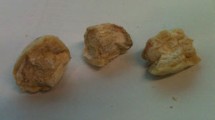Abstract
Sialolithiasis is one of the common diseases of the salivary glands. It was speculated that, in the process of calculi formation, degenerative substances are emitted by saliva and calcification then occurs around these substances, and finally calculi are formed. However, the exact mechanism of the formation of calculi is still unclear. In this study, we identify some possible etiologies of calculi formation in salivary glands through biophysical analysis. Calculi from 13 patients with submandibular sialolithiasis were investigated by transmission electron microscopy, scanning electron microscopy, X-ray microanalyzer, and electron diffraction. Transmission electron microscopic observation of calculi was performed in the submandibular gland (n = 13). In 3 of the 13 cases, a number of mitochondria-like structures and lysosomes were found near calcified materials. Scanning electron microscopic examination of these materials revealed that there were lamellar and concentric structures and that the degree of calcification was different among the calculi. X-ray microanalysis disclosed the component elements in the calculi to be Ca, P, S, Na, etc., and the main constituents were Ca and P. The calcium-to-phosphorus ratio was 1.60–1.89. Analysis of the area including mitochondria-like structures, lysosomes, and the fibrous structures by electron diffraction revealed the presence of hydroxyapatite and calcified materials. It is speculated that mitochondria and lysosomal bodies from the ductal system of the submandibular gland are an etiological source for calcification in the salivary gland.
Similar content being viewed by others
References
A Blitzer (1987) ArticleTitleInflammatory and obstructive disorders opf salivary glands J Dent Res 66 675–679 Occurrence Handle3305643
L Bonder (1993) ArticleTitleSalivary gland calculi: diagnostic imaging and surgical management Compend Contin Educ Dent 14 572–584
N Tanaka S Ichinose Y Adachi M Mimura Y Kimijima (2003) ArticleTitleUltrastructural analysis of salivary calculus in combination with X-ray microanalysis Med Electron Microsc 36 120–126 Occurrence Handle12825126
L Bonder M Grosky (1996) ArticleTitleParotid gland secretion of the aging rat Arch Gerontol Geriatr 22 63–69 Occurrence Handle15374194
MP Escudier N Anthony (1999) ArticleTitleThe management of sialolithiasis in 2 children through use of extracorporeal shock wave lithotripsy Oral Surg Oral Med Oral Pathol Oral Radiol Endod 88 44–49 Occurrence Handle10442944
H Iro HT Schneider C Fodra G Waitz N Nitsche HH Heinritz J Benninger C Ell (1992) ArticleTitleShockwave lithotripsy of salivary duct stones Lancet 339 1333–1336 Occurrence Handle10.1016/0140-6736(92)91968-E Occurrence Handle1349999
H Iro J Zenk W Benzel (1995) Minimally invasive therapy for sialolithiasis: the state of the art EN Myers CD Bluestone DE Brackmann CJ Krause (Eds) Advances in otolaryngology: head and neck surgery, vol 9 Mosby St. Louis 31–48
H Wakae T Tomioka (1998) Salivary calcus K Hashimoto (Eds) Electron microscopic atlas of oral disease Nagasue Shoten Kyoto 52–53
N Tanaka K Sugihara T Odajima M Mimura Y Kimijima S Ichinose (2002) ArticleTitleOral squamous cell carcinoma: electron microscopic and immunohistochemical characteristics Med Electron Microsc 35 127–138 Occurrence Handle10.1007/s007950200016 Occurrence Handle12353133
A Triantafyllou JD Harrison JR Garrett (1993) ArticleTitleProduction of salivary microlithiasis in cats by parasympathectomy: light and electron microscopy Int J Exp Pathol 74 103–112 Occurrence Handle8471530
M Mimura N Tanaka Y Kimijima S Ichinose K Sasaki T Amagasa (2002) ArticleTitleAn ultrastructural study of calcified odontogenic cyst – especially calcified material Med Electron Microsc 35 109–116 Occurrence Handle10.1007/s007950200014 Occurrence Handle12181653
A Epivatianos JD Harrison T Dimitriou (1987) ArticleTitleUltrastructural and histochemical observations on microcalculi in chronic submanbibular sialadenitis J Oral Pathol 16 514–517 Occurrence Handle3127566
A Epivatianos JD Harrison (1989) ArticleTitleThe presence of microcalculi in normal human submandibular and parotid salivary glands Arch Oral Biol 34 261–265 Occurrence Handle10.1016/0003-9969(89)90066-6 Occurrence Handle2597019
J Scott (1978) ArticleTitleThe prevalence of consolidated salivary deposits in the small ducts of human submandibular glands J Oral Pathol 7 28–37 Occurrence Handle418161
JD Harrison A Epivatianos SN Bhatia (1997) ArticleTitleRole of microliths in the aetiology of chronic submandibular sialadenitis: a clinicopathological investigation of 154 cases Histopathology (Oxf) 31 237–251 Occurrence Handle10.1046/j.1365-2559.1997.2530856.x
G Anneroth CM Eneroth G Isacsson (1977) ArticleTitleThe relation of lipids to the mineral components in salivary calculi J Oral Pathol 6 373–381 Occurrence Handle412930
AL Boskey BD Boyan-Salyers LS Burstein ID Mandel (1981) ArticleTitleLipid associated with mineralization of human submandibular gland sialoliths Arch Oral Biol 26 779–785 Occurrence Handle10.1016/0003-9969(81)90173-4 Occurrence Handle6277290
J Ennever JJ Vogel LA Benson (1973) ArticleTitleLipid and calculus matrix calcification in vitro J Dent Res 52 1056–1059 Occurrence Handle4517744
J Harirll J King W Boyce (1959) ArticleTitleStructure and composition of salivary calculi Laryngoscope 69 482–492
Author information
Authors and Affiliations
Corresponding author
Rights and permissions
About this article
Cite this article
Mimura, M., Tanaka, N., Ichinose, S. et al. Possible etiology of calculi formation in salivary glands: biophysical analysis of calculus. Med Mol Morphol 38, 189–195 (2005). https://doi.org/10.1007/s00795-005-0290-7
Received:
Accepted:
Issue Date:
DOI: https://doi.org/10.1007/s00795-005-0290-7




